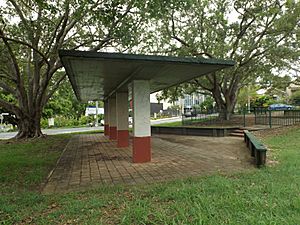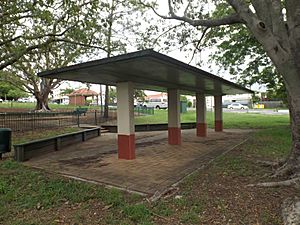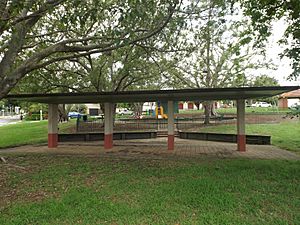Hefferan Park Air Raid Shelter facts for kids
Quick facts for kids Hefferan Park Air Raid Shelter |
|
|---|---|

Structure in 2015
|
|
| Location | 260 Annerley Road, Annerley, City of Brisbane, Queensland, Australia |
| Design period | 1939–45 (World War II) |
| Built | c. 1942 |
| Architect | Frank Gibson Costello |
| Official name: Hefferan Park Air Raid Shelter | |
| Type | state heritage (built) |
| Designated | 6 April 2005 |
| Reference no. | 602472 |
| Significant period | 1942 (fabric) 1940s (historical) |
| Builders | Brisbane City Council |
| Lua error in Module:Location_map at line 420: attempt to index field 'wikibase' (a nil value). | |
The Hefferan Park Air Raid Shelter is a special building in Annerley, Queensland, Australia. It was built around 1942 during World War II to protect people from air raids. An air raid is when enemy planes attack a city from the sky. This shelter was designed by Frank Gibson Costello and built by the Brisbane City Council. Today, it's a heritage-listed site, meaning it's an important part of history that needs to be protected. Hefferan Park was named after a local council member, William Vincent Hefferan.
Contents
History
Why Shelters Were Needed
In 1942, the Brisbane City Council built this concrete shelter in Hefferan Park. This was a time of great worry for Australia. On December 7, 1941, the United States joined World War II after Japan attacked their navy at Pearl Harbor in Hawaii. Soon after, Japanese planes bombed Darwin, Australia, in February 1942. Many Australian soldiers were also captured when Singapore fell.
People in Australia became very concerned about a possible Japanese invasion. Queensland became a key base for the war in the Pacific. Many Australian and American soldiers came to Queensland. They needed new buildings and facilities quickly.
Brisbane's population grew a lot. It was the biggest city in Queensland and the most northern major city in Australia. Because of this, military leaders set up their headquarters in Brisbane. General Douglas MacArthur, the leader of the Allied Forces, worked from a building in Brisbane. General Sir Thomas Blamey, the leader of the Australian Forces, used the University of Queensland buildings. Brisbane was an important target, so protecting its people from air raids was urgent.
Building Shelters in Brisbane
Building shelters needed a lot of materials and workers. Military projects were the top priority. Large anti-aircraft guns were set up in places like Victoria Park and Hendra. Coastal guns were placed on Bribie and Moreton Islands. Before the war, Queensland didn't have many factories. To help, some buildings were made in parts and then put together. Designs were kept simple because skilled workers and some materials were hard to find.
The Brisbane City Council was in charge of Air Raid Precautions (ARP). This included setting up air raid wardens, firefighting systems, and building shelters. Saltwater pipes were laid in city streets for firefighting. In December 1941, everyone was told to start building shelters. Simple Slit trenches were dug in parks and schoolyards. Windows were taped, and lights were dimmed at night to make cities harder to see from the air.
The Premier of Queensland, William Forgan Smith, ordered the Brisbane City Council to build 200 public shelters in the city. Work began quickly, and later, another 75 shelters were ordered. In the end, 235 air raid shelters were built. Most were finished by June 1942. Also, about three kilometers of covered trenches were built in public parks. These trenches could hold many people. The Council also built shelters for wharves and other council properties.
Other towns along the Queensland coast also had to build shelters. They followed special rules for how strong the shelters needed to be. Some towns had trouble building enough shelters, so the government helped.
Clever Designs for After the War
Out of 235 public shelters built in Brisbane, 21 are still standing today. Most of these surviving shelters were designed to be reused after the war. They were called "pillbox" shelters. They came in three main types: "park," "bus," and "bus (stone)." These shelters were planned to become things like bus stops or shade structures in parks. Parts of their outer walls could be removed, leaving the roof and supporting pillars. These reusable shelters were designed to hold 70 people.
Frank Gibson Costello, the Brisbane City Council Architect from 1941 to 1952, designed these clever shelters. He wanted to make sure that if the shelters weren't needed for air raids, they wouldn't just be useless concrete blocks. He planned them so they could be changed into something useful for the city after the war.
Costello's designs were modern for their time. They used simple shapes and strong materials like concrete. They often had flat roofs and clean lines. Many of these reusable shelters were built under large fig trees. This helped to hide them from enemy planes.
One type was the "park" shelter. It had four central pillars holding up the roof. Its four outer walls could be taken down after the war. There were entrances at both ends of the front wall. About 17 of these "park" type shelters still exist today. The Hefferan Park shelter is one of them. Many are now used as simple park shelters, just as planned.
Another type was the "bus" shelter. These were designed so that three brick walls could be removed, leaving a concrete back wall and five brick pillars at the front. Only two of these "bus" type shelters are still around.
The third type was also a "bus" shelter, but it had a stone back wall and six stone pillars. Only one of these "bus (stone)" shelters remains.
Most of the buildings made for the war were removed after World War II ended. The saltwater pipes, trenches, and sirens disappeared. Many standard pillbox shelters in the city center were also taken down. But Costello's reusable shelters were different. Because their walls could be removed, they found new uses. This is why 20 of his 58 reusable public shelters are still here today.
The outer walls of the Hefferan Park air raid shelter were removed after World War II, just as planned. You can still see where the walls used to be. The shelter's roof and pillars have been painted, and the floor has new pavers.
What the Shelter Looks Like
The Hefferan Park air raid shelter is a rectangular concrete building. It has a strong floor and a flat roof supported by concrete pillars. It stands next to a playground under big fig trees at the northern end of Hefferan Park. This park is located at a busy road intersection, close to the Dutton Park railway station. The shelter's roof is painted light green. The bottom parts of the pillars are red, and the top parts are white. The floor inside the shelter is paved with red and white pavers in a diagonal pattern.
Why This Shelter is Special
The Hefferan Park Air Raid Shelter was added to the Queensland Heritage Register on April 6, 2005. This means it's officially recognized as an important historical site.
- It shows how Queensland's history changed.
This shelter is important because it shows how people in Brisbane prepared for war during World War II. It protected people from air raids and shows how the war affected everyday life in the city.
- It's a rare example of its kind.
Many air raid shelters were built during World War II, but not many are still standing. This shelter is one of the few types of wartime buildings made by the Brisbane City Council that still exists.
- It shows what a typical air raid shelter was like.
Its strong build, rectangular shape, and location near a busy area show what a public air raid shelter in Brisbane during World War II was like.
- It shows clever design for its time.
The Hefferan Park shelter is now used as a park shelter. This shows how it was designed to have a second use after the war. It's a great example of smart design and how concrete was used in new ways during World War II.
- It's linked to important people and groups.
This air raid shelter is an example of the work done by the City Architect's Office during the war, especially the designs by City Architect F.G. Costello.



